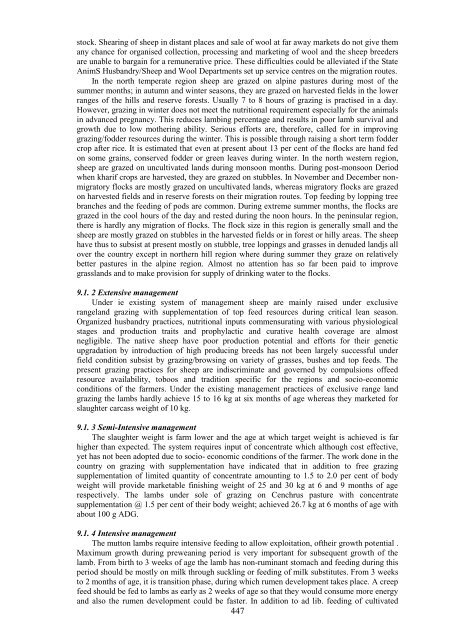Create successful ePaper yourself
Turn your PDF publications into a flip-book with our unique Google optimized e-Paper software.
stock. Shearing of sheep in distant places and sale of wool at far away markets do not give them<br />
any chance for organised collection, processing and marketing of wool and the sheep breeders<br />
are unable to bargain for a remunerative price. These difficulties could be alleviated if the State<br />
AnimS Husbandry/<strong>Sheep</strong> and Wool Departments set up service centres on the migration routes.<br />
In the north temperate region sheep are grazed on alpine pastures during most of the<br />
summer months; in autumn and winter seasons, they are grazed on harvested fields in the lower<br />
ranges of the hills and reserve forests. Usually 7 to 8 hours of grazing is practised in a day.<br />
However, grazing in winter does not meet the nutritional requirement especially for the animals<br />
in advanced pregnancy. This reduces lambing percentage and results in poor lamb survival and<br />
growth due to low mothering ability. Serious efforts are, therefore, called for in improving<br />
grazing/fodder resources during the winter. This is possible through raising a short term fodder<br />
crop after rice. It is estimated that even at present about 13 per cent of the flocks are hand fed<br />
on some grains, conserved fodder or green leaves during winter. In the north western region,<br />
sheep are grazed on uncultivated lands during monsoon months. During post-monsoon Deriod<br />
when kharif crops are harvested, they are grazed on stubbles. In November and December nonmigratory<br />
flocks are mostly grazed on uncultivated lands, whereas migratory flocks are grazed<br />
on harvested fields and in reserve forests on their migration routes. Top feeding by lopping tree<br />
branches and the feeding of pods are common. During extreme summer months, the flocks are<br />
grazed in the cool hours of the day and rested during the noon hours. In the peninsular region,<br />
there is hardly any migration of flocks. The flock size in this region is generally small and the<br />
sheep are mostly grazed on stubbles in the harvested fields or in forest or hilly areas. The sheep<br />
have thus to subsist at present mostly on stubble, tree loppings and grasses in denuded landjs all<br />
over the country except in northern hill region where during summer they graze on relatively<br />
better pastures in the alpine region. Almost no attention has so far been paid to improve<br />
grasslands and to make provision for supply of drinking water to the flocks.<br />
9.1. 2 Extensive management<br />
Under ie existing system of management sheep are mainly raised under exclusive<br />
rangeland grazing with supplementation of top feed resources during critical lean season.<br />
Organized husbandry practices, nutritional inputs commensurating with various physiological<br />
stages and production traits and prophylactic and curative health coverage are almost<br />
negligible. The native sheep have poor production potential and efforts for their genetic<br />
upgradation by introduction of high producing breeds has not been largely successful under<br />
field condition subsist by grazing/browsing on variety of grasses, bushes and top feeds. The<br />
present grazing practices for sheep are indiscriminate and governed by compulsions offeed<br />
resource availability, toboos and tradition specific for the regions and socio-economic<br />
conditions of the farmers. Under the existing management practices of exclusive range land<br />
grazing the lambs hardly achieve 15 to 16 kg at six months of age whereas they marketed for<br />
slaughter carcass weight of 10 kg.<br />
9.1. 3 Semi-Intensive management<br />
The slaughter weight is farm lower and the age at which target weight is achieved is far<br />
higher than expected. The system requires input of concentrate which although cost effective,<br />
yet has not been adopted due to socio- economic conditions of the farmer. The work done in the<br />
country on grazing with supplementation have indicated that in addition to free grazing<br />
supplementation of limited quantity of concentrate amounting to 1.5 to 2.0 per cent of body<br />
weight will provide marketable finishing weight of 25 and 30 kg at 6 and 9 months of age<br />
respectively. The lambs under sole of grazing on Cenchrus pasture with concentrate<br />
supplementation @ 1.5 per cent of their body weight; achieved 26.7 kg at 6 months of age with<br />
about 100 g ADG.<br />
9.1. 4 Intensive management<br />
The mutton lambs require intensive feeding to allow exploitation, oftheir growth potential .<br />
Maximum growth during preweaning period is very important for subsequent growth of the<br />
lamb. From birth to 3 weeks of age the lamb has non-ruminant stomach and feeding during this<br />
period should be mostly on milk through suckling or feeding of milk substitutes. From 3 weeks<br />
to 2 months of age, it is transition phase, during which rumen development takes place. A creep<br />
feed should be fed to lambs as early as 2 weeks of age so that they would consume more energy<br />
and also the rumen development could be faster. In addition to ad lib. feeding of cultivated<br />
447




